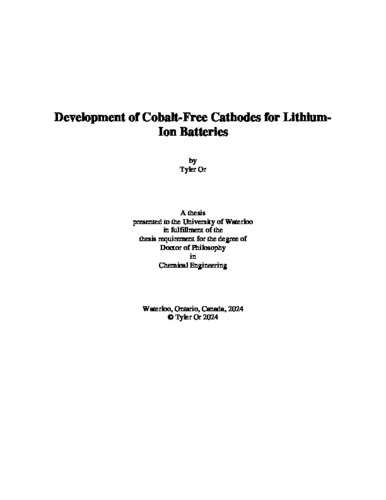| dc.description.abstract | Lithium-ion batteries (LIBs) are the dominant energy story technology for mobile devices and plug-in electric vehicles due to their unmatched combination of energy density, power output, and cycle stability. A coveted goal in their development is the expansion of energy density, which is currently bottlenecked by the charge storage capacity of the cathode material. Moreover, the ramp-up and projected growth of LIB production raises concerns over the availability and cost of raw resources, particularly on the reliance of cobalt in the cathode material. To suit these requirements, layered structure LiNixMnyCozO2 (NMC, x + y + z = 1) class materials are the most commercially relevant, with ongoing efforts to increase the Ni to Co ratio. Although Ni-rich NMC cathodes (x ≥ 0.8) can achieve higher energy densities, their applicability is limited due to the poor cycle life and safety. Thus, it is critical to develop strategies to address these problems. In general, the performance of electrode materials can be modified by 1) altering the particle morphology, 2) applying a surface coating, 3) applying a transition metal dopant, and 4) modifying the electrolyte composition to suppress deleterious electrode-electrolyte side reactions, all of which were explored in this work. The electrochemical performance of single crystal LiNi0.83Mn0.06Co0.11O2 (SC-NMC811) electrodes was enhanced by coatings applied with atomic layer deposition (ALD). The performance of various coating materials (Al2O3, alucone, TiO2, and titanicone) was thoroughly compared and their mechanisms were analyzed. As the coating was applied on the fabricated electrode, it was observed to be localized on the electrode surface. Thus, it was concluded that the ALD-applied coatings primarily act by accelerating the decomposition of LiPF6, coating the cathode with fluoride and phosphate species that passivate its surface. The coatings were most effective at improving cycle stability at low currents, where capacity degradation is dominated by active material loss from HF corrosion. At elevated currents, kinetic factors dictate capacity degradation, which minimized the impact of the ALD-applied coatings. Preliminary investigation was also conducted on the relationship between coatings and electrolyte additives, which share many mechanisms. In subsequent work, Zr and Ce-based coatings were formed on SC-NMC811 particles by sintering. Consequently, doping within the particle bulk can also occur. The coating thickness and extent of doping were optimized in order to delineate the various improvement mechanisms. Doping was found to improve cycle stability at elevated currents, likely due to its improvement of Li+ diffusion kinetics and suppression of lattice volume evolution. However, the thickness of the coating should be minimized, particularly when cycling at elevated currents, due to the rapid build-up of surface impedance. Finally, SC-NMC811 was cycled with a passivating high concentration LiFSI-based electrolyte, with its cycle stability further enhanced by incorporating coatings. Under this unconventional electrolyte system, the passivation mechanism of the coatings was proposed. | en |

